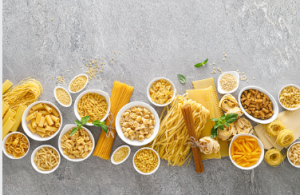Pasta is a type of food that is made from an unleavened dough of wheat flour. It is usually formed into sheets and then boiled or baked. During the cooking process, the dough is manipulated to create different shapes and varieties.
Shapes
In the world of pasta, there are more shapes and sizes than you can shake a stick at. They are used for everything from salads to soups. Some of the most familiar shapes include penne, farfalle, and spaghettini.
 There are also more unusual kinds of pasta. For example, a cavatappi is a hollow spiral, often served with a tomato-based sauce. It is named after the Italian singer Celentano. The ridges on the surface help to hold the sauce.
There are also more unusual kinds of pasta. For example, a cavatappi is a hollow spiral, often served with a tomato-based sauce. It is named after the Italian singer Celentano. The ridges on the surface help to hold the sauce.
Another attractive shape is the cascatelli. This curved pasta resembles the love child of the creste di galle and the mafaldine, and this is a good choice if you make a caprese pasta salad.
Similarly, the troccoli is a string-like Adelaide pasta shaped like a square. It’s also a good choice for capturing sauce.
You’ll be hard-pressed to find a shape of pasta that’s not associated with a particular dish. Aside from the classic penne and spaghetti, you can find an array of less common shapes, such as anelli, cappelleti, and pincinelle.
The most important thing to understand about pasta is that it’s not one size fits all. That’s why you can enjoy it with sauces ranging from light and oily to rich and creamy. Choosing the correct pasta can distinguish between a bland and delicious meal.
One of the earliest forms of processed food, pasta has a long history. While pasta has been manufactured since the era of the Greeks, industrially produced versions started popping up towards the end of the nineteenth century. These were made using an extrusion press, which produced a massive range of shapes.
Of course, the most obvious way to create pasta is to roll sheets of dough. However, machines have come along and sped up the process. An extrusion die is then inserted into the dough. From there, it’s forcefully squeezed through, resulting in the shape.
Varieties
The variations of Adelaide pasta come in many different shapes and sizes. It is an excellent source of nutrition and energy. This versatile food has been around for thousands of years. There are hundreds of different varieties to choose from. You can dress it with sauce, protein, and vegetables. And there are many regional kinds of pasta as well.
Spaghetti, or simply spaghetti, is one of the most commonly used portions of pasta. It’s a low glycemic index food that is served with a variety of sauces. Most spaghetti is made from durum wheat and is creamy yellow. However, you can find spaghetti made from semolina flour as well.
Other common types of pasta include cavatuneddi, cortecce, gnocchetti, strascinati, and manicotti. These plates of pasta can be stuffed with various fillings, such as spinach, cheese, or other ingredients.
Pasta is a staple in the pantry. While it is traditionally cooked in meat or vegetable sauces, it is also used in pasta salads and casseroles. Many people stick to the same types of pasta, but several regional and unique shapes can spice up a pasta recipe.
Tortellini is another type of stuffed pasta. Tortellini are often loaded with ricotta cheese and usually served with meat or cheese sauces.
Stuffed pasta can also come in the form of ravioli. Ravioli are a homemade type of pasta. People often use this pasta to add a boost of flavour. Ravioli is available in canned or homemade forms.
Ingredients
There are various types of pasta. Most are made from flour and eggs. A few other ingredients are used to improve the quality of the food.
Pasta is a typical food in many cultures and is eaten worldwide. Many people eat it several times a week.
Pasta can be served with a variety of sauces. These can be traditional, such as tomatoes, olive oil, cheese, or other ingredients. In addition, some people use aromatic herbs to add flavour to their pasta.
Pasta can be fortified with protein, vitamins, and dietary fibre. A few of the most popular foods fortified with these elements include whole wheat pasta, buckwheat pasta, and amaranth pasta.
Pasta is rich in complex carbohydrates. They help regulate blood sugar and provide sustained energy. Also, pasta is low in total fat.
Pasta can be baked or boiled. Typically, pasta is cooked on the stovetop. Then, water is added to the dough and boiled until it is al dente.
For good taste, the cooking time must be adequate. Cooking time also affects the texture and moisture content of the final product.
The nutritional quality of pasta can be enhanced by varying the types of ingredients that are added. Traditionally, pasta is made of wheat and eggs. However, other grains, such as barley and buckwheat, can produce similar noodles.
Whole wheat pasta is an excellent example of a food rich in fibre. Buckwheat is also a great choice because it contains high levels of protein.



